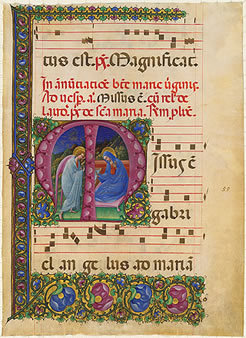Heaven on Earth
dal 28/2/2009 al 1/8/2009
Segnalato da
28/2/2009
Heaven on Earth
National Gallery of Art, Washington
Manuscript Illuminations from the National Gallery of Art. Fifty-two single leaves and four bound volumes, among them a number of important recent acquisitions, date from the 12th to the 16th century and were made in France, Germany, Austria, Bohemia, the Netherlands, Spain, and Italy. Comprehensive wall texts will include new scholarly information, uncovered since the last time these works were exhibited.

curated by Virginia Grace Tuttle
Rare medieval manuscript illuminations, last exhibited in 1975, will be showcased in a stunning installation, Heaven on Earth: Manuscript Illuminations from the National Gallery of Art, on view in the East Building from March 1 through August 2, 2009. Fifty-two single leaves and four bound volumes, among them a number of important recent acquisitions, date from the 12th to the 16th century and were made in France, Germany, Austria, Bohemia, the Netherlands, Spain, and Italy. Comprehensive wall texts will include new scholarly information, uncovered since the last time these works were exhibited.
"Protected inside closed volumes on library shelves for centuries, many of the images are today as breathtakingly vibrant and beautiful as they were centuries ago," said Earl A. Powell III, director, National Gallery of Art.
Exhibition Support
The exhibition was organized by the National Gallery of Art.
The exhibition is supported in part by a generous grant from the Thaw Charitable Trust.
Manuscripts at the National Gallery of Art
Heaven on Earth offers the first in-depth look at these rare works of art in Washington since the 1975 exhibition Medieval and Renaissance Miniatures from the National Gallery of Art, the initial showing of the 49 leaves and cuttings from the illuminated manuscripts in the Rosenwald Collection. To accompany the 1975 exhibition, the Gallery published an extensive catalogue (now out of print) that set a new standard for scholarly accomplishment in the study of medieval manuscript illumination. Although the catalogue authors greatly advanced knowledge of the Rosenwald miniatures, now much more is known about the often anonymous artists or the places and dates of the manuscripts' origin.
In the last three decades, interest in illuminated manuscripts has grown tremendously, resulting in an abundance of authoritative publications. Manuscript collections in both the United States and Europe that were previously unknown, inaccessible, or unpublished are now readily available for study in a wide range of fully illustrated books and articles, leading to new attributions. This wealth of new information has enabled the Gallery to reexamine its miniatures in the vastly enriched context of recently discovered and related works of art and to answer many of the questions left unresolved in 1975.
Recent reattributions by Gallery curator Virginia Tuttle include Fra Gregorio Mutii da Montalcino’s Death of Saint Benedict, formerly attributed as late 14th century Italian, and Saint Peter Enthroned, (c. 1420), which was thought to have been made by a follower of Lippo Vanni, however,Tuttle has confirmed that the miniature is in fact by Sienese artist Lippo Vanni.
An important recent acquisition, The Three Maries at the Tomb with the Angel of the Resurrection (1274/1280) by The Master of Imola, also Sienese, was instrumental in leading Tuttle to the conclusion that another work in the Gallery’s collection, The Nativity with Six Dominican Monks (1265/1274) was by the same artist. The Gallery’s scientific laboratories cooperated closely with Tuttle in analyzing these works.
The Exhibition
Prior to the invention of the printing press in the 15th century, texts were laboriously inscribed by hand on carefully prepared parchment made from the skin of sheep or calves. Artists adorned the most luxurious books with painted decorations, known as "illuminations" because the frequent use of gold leaf made the pages glow. GIven the time, effort, and materials required for their production, illuminated manuscripts were extremely precious works of art treasured by their owners.
The majority of the works in the exhibition depict a range of sacred subjects, as the books most commonly illuminated throughout the Middle Ages were bibles and liturgical texts used in church services and in the daily cycle of prayers offered by communities of monks and nuns. In the late Middle Ages the most popular illuminated books were private devotional texts, called "books of hours," prepared for well-to-do patrons. Secular texts were also illustrated and are represented in the exhibition by manuscripts treating canon law, ancient history, and civic statutes, as seen here in The Meeting of Achilles and Hector, from Histoire Ancienne Jusqu' à César (c. 1450).
Most of the miniatures in this exhibition are single leaves or cuttings that have been removed from manuscripts. In the 19th century collectors often cut illustrated pages or illuminated initials out of manuscripts to frame them as independent works of art. That practice is now condemned. Once outside the protection of their books, illuminations are increasingly subject to damage and loss, and their original contexts become difficult to trace.
Exhibition Curator and Related Activities
The exhibition curator is Virginia Grace Tuttle, associate curator of old master prints, National Gallery of Art, Washington. Gallery talks in the exhibition will be held at 12 noon on March 6, 13, April 2, 28, and May 7, 19, and 27; and at 1 p.m. on March 12 and April 19.
Press contact: Deborah Ziska
Chief of Press and Public Information
National Gallery of Art
E-mail: ds-ziska@nga.gov
National Gallery of Art
6th Street and Constitution Avenue - Washington
Monday through Saturday from 10:00 a.m. to 5:00 p.m. and Sunday from 11:00 a.m. to 6:00 p.m.



